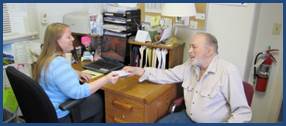AARP Eye Center
No Wrong Door: Promising Practices for Accessing Long-Term Services and Supports
By Wendy Fox-Grage, June 6, 2017 12:12 PM

Most of us will need long-term services and supports (LTSS), either for ourselves or for our family members. However, most of us do not know about our options and how to pay for these services. That is why the LTSS State Scorecard — created by the AARP Public Policy Institute and funded by the Scan Foundation and the Commonwealth Fund — ranks states on their aging and disability resource centers. These centers are an important feature of a high-performing LTSS system.
Aging and disability resource centers can serve as the gateway for helping individuals and their families find and access LTSS, including light housekeeping, transportation and respite care to give family caregivers a break, just to name a few. States have these “one-stop shopping” models to help people receive public and private services regardless of which organization they contact. Therefore, they are sometimes called “ no wrong door .” If people contact an organization within this system, they can be connected with information, referrals and supports, resulting in “no wrong door” to services irrespective of their age, income or disability. Area agencies on aging, centers for independent living, and state agencies such as Medicaid agencies and state units on aging work together to make up this no wrong door system. While the states have these centers, the operations and functions of each center vary greatly, which is why the Scorecard ranks them.
Although the previous two Scorecards included an indicator on these centers, the upcoming third edition contains an updated indicator to reflect published guidance on key elements of no wrong door systems from the federal government. AARP, in collaboration with the U.S. Administration for Community Living and the Lewin Group, collected information for this indicator from a survey of state administrators. Then, they followed up by interviewing administrators from states that had scored well or demonstrated innovation to produce a newly released promising practices and tool kit paper on person- and family-centered practices.
This first in a series of promising practices and tool kit papers provides concrete examples of how six states — Connecticut, Michigan, New Hampshire, Virginia, Washington and Wisconsin — plus the District of Columbia promote person- and family-centered practices in their no wrong door systems. These centers are using an interactive process directed by individuals and family members to support decision making. They also help to develop a plan of support that reflects an individual’s and family’s strengths, preferences, needs and values. It affirms the core principle that each person is the expert in his or her own life rather than simply plugging people into programs based on their eligibility.
The promising practices are:
- Ensuring leadership support for these practices (with examples from the District of Columbia’s mayor-led cross-population task force, Michigan’s broad support for change, and Virginia’s state legislation on this practice);
- Creating standards for these practices (with examples from Washington’s statewide standards of practice, Virginia’s co-employment model between aging and disability organizations, the District of Columbia’s intake to better listen to people and families, and Wisconsin’s follow-up);
- Training the “no wrong door” workforce (with examples from New Hampshire’s training and certification, the District of Columbia’s training for all, New Hampshire’s peer support model, Virginia’s person-centered advocates, and Connecticut’s essay exam); and
- Helping people maximize use of private resources (with an example from Wisconsin that has been a leader in serving private-pay clients).
This promising practices and tool kit paper includes resources and contacts for state and federal administrators, providers, and advocates to learn about — and even replicate — these practices. This paper also provides a checklist of what is needed to move toward more person- and family-centered practices.
NOTE: The third edition of the Scorecard will be released soon … on June 14. Promising practices and tool kits are a new feature of the Scorecard project. More papers — such as promising practices in preventing long-term nursing home stays — will be forthcoming. For the new Scorecard, the promising practices and tool kit papers, and more, please go to the LTSS State Scorecard interactive website at www.longtermscorecard.org.
























































